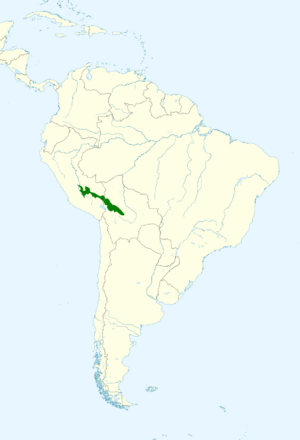Fulvous wren facts for kids
Quick facts for kids Fulvous wren |
|
|---|---|
| Conservation status | |
| Scientific classification | |
| Genus: |
Cinnycerthia
|
| Species: |
fulva
|
 |
|
| Synonyms | |
|
|
The fulvous wren (Cinnycerthia fulva) is a small bird that lives in the Andes mountains. It belongs to the wren family, called Troglodytidae. You can find this bird in Bolivia and Peru.
Contents
About the Fulvous Wren's Family
Birds are often grouped into families. The fulvous wren was once thought to be a type of Peruvian wren. Back then, the Peruvian wren was called the sepia-brown wren.
The fulvous wren, the Peruvian wren, and another bird now called the sepia-brown wren (C. olivascens) are all very closely related. They form a special group called a "superspecies."
The fulvous wren itself has three different types, or subspecies. These are:
- the main type, called Cinnycerthia fulva fulva
- C. f. fitzpatricki
- C. f. gravesi
What Does the Fulvous Wren Look Like?
The fulvous wren is about 14.5 cm (5.7 in) long. Male wrens usually weigh around 18.4 g (0.65 oz), while females are a bit lighter, weighing about 14.8 g (0.52 oz).
The main type of fulvous wren has a reddish-brown head and back. Its rump (the lower back) is even redder. It has a light, buff-colored stripe above its eye, which is called a supercilium. There's also a dull brown stripe near its eye and buffy cinnamon cheeks. Its tail is reddish-brown with thin, dark bars across it.
The throat of this wren is a buffy white. Its chest is a buffy cinnamon color, which gets darker and more reddish-brown on its sides and belly.
Differences in Subspecies
The C. f. fitzpatricki subspecies has a darker head and a lighter stripe above its eye compared to the main type. The C. f. gravesi subspecies has a whitish stripe above its eye and lighter underparts.
Young fulvous wrens look similar to the adults, but their heads are a bit grayish.
Where the Fulvous Wren Lives
The main type of fulvous wren lives in the eastern Andes mountains of Peru. You can mostly find it in the Department of Cuzco.
The C. f. fitzpatricki subspecies lives in the Vilcabamba mountain range, which is also in Cuzco, Peru.
The C. f. gravesi subspecies is found from southern Peru's Department of Puno all the way south to central Bolivia's Cochabamba Department.
These wrens prefer to live in wet montane forests. These are forests found in mountains, usually between 1,500 and 3,300 m (4,900 and 10,800 ft) high.
Fulvous Wren Behavior
How the Fulvous Wren Finds Food
The fulvous wren looks for its food on the ground and in low plants. It often does this in small groups, or flocks. Scientists don't have a lot of details about what exactly these wrens eat.
Reproduction and Life Cycle
Not much is known about how the fulvous wren breeds. We do know that some wrens in Bolivia were found to be ready to breed in January.
Fulvous Wren Sounds
The songs and calls of the fulvous wren have not been officially described by scientists. However, you can listen to examples of their sounds online:
- An example of its song
- An example of its call
Conservation Status
The IUCN (International Union for Conservation of Nature) has looked at the fulvous wren. They have decided that it is a species of "Least Concern." This means that the bird is not currently in danger of disappearing.
Even though its exact population size isn't known, the fulvous wren is described as being fairly common in some places. However, scientists still don't know a lot about this bird in general.


